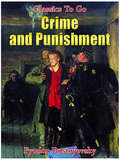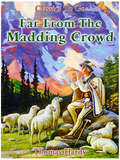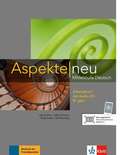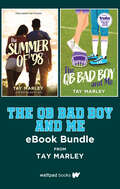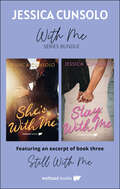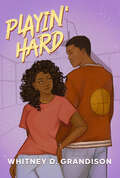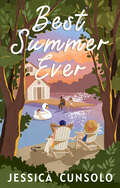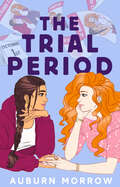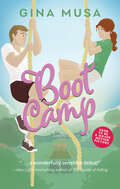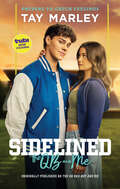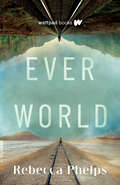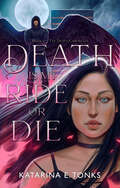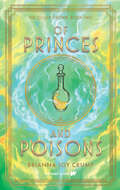- Table View
- List View
Crime and Punishment: Revised Edition Of Original Version (Classics To Go #394)
by Fyodor DostoyevskyRodion Romanovich Raskolnikov, a former student, lives in a tiny garret on the top floor of a run-down apartment building in St. Petersburg. He is sickly, dressed in rags, short on money, and talks to himself, but he is also handsome, proud, and intelligent. He is contemplating committing an awful crime, but the nature of the crime is not yet clear. He goes to the apartment of an old pawnbroker, Alyona Ivanovna, to get money for a watch and to plan the crime. Afterward, he stops for a drink at a tavern, where he meets a man named Marmeladov, who, in a fit of drunkenness, has abandoned his job and proceeded on a five-day drinking binge, afraid to return home to his family. Marmeladov tells Raskolnikov about his sickly wife, Katerina Ivanovna, and his daughter, Sonya, who has been forced into prostitution to support the family. Raskolnikov walks with Marmeladov to Marmeladov’s apartment, where he meets Katerina and sees firsthand the squalid conditions in which they live.
Far from the Madding Crowd: Revised Edition Of Original Version (Classics To Go)
by Thomas HardyGabriel Oak is a young shepherd. With the savings of a frugal life, and a loan, he has leased and stocked a sheep-farm. He falls in love with a newcomer eight years his junior, Bathsheba Everdene, a proud beauty who arrives to live with her aunt, Mrs. Hurst. She comes to like him well enough, and even saves his life once, but when he makes her an unadorned offer of marriage, she refuses; she values her independence too much and him too little. Gabriel's blunt protestations only serve to drive her to haughtiness. After a few days, she moves to Weatherbury, a village some miles off. When next they meet, their circumstances have changed drastically. An inexperienced new sheep dog drives Gabriel's flock over a cliff, ruining him. After selling off everything of value, he manages to settle all his debts, but emerges penniless. He seeks employment at a work fair in the town of Casterbridge, (a fictionalised version of Dochester). When he finds none, he heads to another fair in Shottsford, a town about ten miles from Weatherbury. On the way, he happens upon a dangerous fire on a farm and leads the bystanders in putting it out. When the veiled owner comes to thank him, he asks if she needs a shepherd. She uncovers her face and reveals herself to be none other than Bathsheba. She has recently inherited the estate of her uncle and is now a wealthy woman. Though somewhat uncomfortable, she hires him. Meanwhile, Bathsheba has a new admirer: the lonely and repressed William Boldwood. Boldwood is a prosperous farmer of about forty whose ardour Bathsheba unwittingly awakens when – her curiosity piqued because he has never bestowed on her the customary admiring glance – she playfully sends him a valentine sealed with red wax on which she has embossed the words "Marry me". Boldwood, not realising the valentine was a jest, becomes obsessed with Bathsheba, and soon proposes marriage. Although she does not love him, she toys with the idea of accepting his offer; he is, after all, the most eligible bachelor in the district. However, she postpones giving him a definite answer. When Gabriel rebukes her for her thoughtlessness, she fires him. When her sheep begin dying from bloat, she discovers to her chagrin that Gabriel is the only man who knows how to cure them. Her pride delays the inevitable, but finally she is forced to beg him for help. Afterwards, she offers him back his job and their friendship is restored... (Excerpt from Wikipedia)
geni@l klick: German Textbook Level 1
by Ute Koithan Theo Scherling Michael Koenig Yo Rühmer Barbara WelzelNIMAC-sourced textbook
Portfolio Deutsch, German Textbook, Level 4
by Cordula Schurig Sarah Fleer Anette Kannenberg Daniela Kohl Annerose Bergmann Linda Grätz Dagmar Schalliol Stefanie Dengler Paul Rusch Sabine FrankeNIMAC-sourced textbook
Portfolio Deutsch, German Textbook, Level 3
by Cordula Schurig Sarah Fleer Anette Kannenberg Daniela Kohl Annerose Bergmann Linda Grätz Dagmar Schalliol Stefanie Dengler Paul Rusch Sabine FrankeNIMAC-sourced textbook
Portfolio Deutsch, German Textbook, Level 2
by Cordula Schurig Sarah Fleer Anette Kannenberg Daniela Kohl Annerose Bergmann Angela Kilimann Linda Grätz Dagmar Schalliol Stefanie Dengler Paul RuschNIMAC-sourced textbook
Portfolio Deutsch = German Textbook, Level 1
by Ute Koithan Theo Scherling Cordula Schurig Anna Hila Michael Koenig Sarah Fleer Alicia Padrós Anette Kannenberg Daniela Kohl Helen Schmitz Annerose Bergmann Angela Kilimann Linda Grätz Dagmar SchalliolNIMAC-sourced textbook
Klasse! A2: Deutsch für Jugendliche, Intensivtrainer
by Sarah Fleer Bettina Schwieger Margret RodiNIMAC-sourced textbook
Klasse! A2: Deutsch für Jugendliche, Übungsbuch mit Audios
by Ute Koithan Sarah Fleer Tanja Sieber Bettina SchwiegerNIMAC-sourced textbook
Klasse! A2: Deutsch für Jugendliche, Kursbuch mit Audios und Videos
by Ute Koithan Sarah Fleer Tanja Sieber Bettina SchwiegerNIMAC-sourced textbook
Klasse! A1: Deutsch für Jugendliche, Intensivtrainer
by Sarah Fleer Margret RodiNIMAC-sourced textbook
Klasse! A1: Deutsch für Jugendliche, Übungsbuch mit Audios
by Ute Koithan Sarah Fleer Tanja Sieber Bettina SchwiegerNIMAC-sourced textbook
Klasse! A1: Deutsch für Jugendliche, Kursbuch mit Audios und Videos
by Ute Koithan Michael Koenig Sarah Fleer Tanja SieberNIMAC-sourced textbook
Aspekte neu: Mittelstufe Deutsch, Arbeitsbuch 1
by Ute Koithan Helen Schmitz Annerose Bergmann Tanja Sieber Ralf Sonntag Cornelia RademacherNIMAC-sourced textbook
The QB Bad Boy and Me eBook Bundle: A Two Book Bundle including The Summer of '98
by Tay MarleyIncludes the novel that inspired the Tubi movie starring Noah Beck and Siena Agudong!This ebook bundle brings together both of the QB Bad Boy and Me novels from Tay Marley! The QB Bad Boy and MeReluctant cheerleader Dallas Bryan has a problem on her hands—and his name is Drayton Lahey. Ever since the hot star quarterback of the high school football team hit her car with his motorcycle, he has the annoying ability to get under her skin, making Dallas think about Drayton way more than she should . . . in all the ways that she shouldn't. But Dallas has one goal—to pursue her dance-school dreams in California—and no one, not even a hard-bodied, green-eyed football god, will stop her. As the tension between Drayton and Dallas grows thicker, the lines blur, and all she wants is to come undone under his touch.But this thing between Dallas and Drayton could cost her her dreams . . . if he doesn't break her heart first.The Summer of '98Before Drayton and Dallas, there was Ellie and Leroy . . . Sometimes home isn&’t a place, it&’s a person. From the moment their eyes met, Ellie knew he would be her destiny. Handsome and ripped, there&’s just something about Leroy Lahey, Baylor University&’s soon-to-be star quarterback, that makes him impossible to resist. Consumed by a passion neither one of them can quite understand, Leroy and Ellie spend the summer together. Left senseless and overwhelmed by his touch, Ellie experiences a world of desire she could never have imagined. Safe in Leroy&’s arms, Ellie begins to see a life beyond high school: going to college, starting her own business, having a family. But when life-altering news shakes them to their cores, Leroy and Ellie must discover if their passion is enough to help them get through what might possibly be the greatest challenge of their lives.
With Me Series eBook Bundle: She's With Me and Stay With Me
by Jessica CunsoloThis two-book bundle includes She&’s With Me and Stay With Me. Also included is a teaser for the final installment in the trilogy, Still With Me.She&’s With MeArriving in another new town, Amelia Collins vows to fit in and finish her senior year drama free. There can&’t be any mistakes. Staying under the radar is what keeps Amelia one step ahead of the man who is trying to find and destroy her.But when she&’s befriended by a group of students who make her feel safe and loved, Amelia struggles to maintain her distance, especially when faced with her feelings for Aiden Parker, whose piercing gray eyes and strength weaken her resolve.When Aiden&’s ex-girlfriend threatens Amelia in ways that make her easy to find, she has to act quickly. Feeling crushed by her desire for a normal life and not wanting to leave her friends behind, Amelia has an impossible choice to make between survival or the chance at real love. Stay With Me In the sequel to her riveting debut, She&’s With Me, rising star Jessica Cunsolo brings us the dramatic continuation of a romance that always defies the odds . . .Amelia Collins has finally found happiness in the arms of Aiden Parker, who accepts her for who she is—even when their pasts become hopelessly entangled in their present and threaten to completely unravel their futures. As Aiden&’s accused of a crime he didn&’t commit and struggles to keep his family together, Amelia fights a battle of her own: how to tell Aiden she needs to leave.Determined to put real life on hold for just a little bit longer, Amelia and her friends leave the chaos of King City behind for a beach house and holiday celebrations. Still, it&’s only a matter of time before close quarters reveal their secrets, and Aiden fully understands the awful truth about the man pursuing Amelia.Amelia knows she can&’t outrun her painful memories of the past and a killer&’s obsession. Her beloved friends are in danger, and she won&’t let them be harmed. Overwhelmed by love but haunted by fear, Amelia must decide if staying with the person she loves is worth risking his life.
Playin' Hard
by Whitney D. GrandisonReaders of YA contemporary romance, sports romance, enemies-to-lovers stories, and those looking for Black love will be drawn to this title. It&’s perfect for fans of Talia Hibbert&’s Highly Suspicious and Unfairly Cute.DeAndre may be the king of the court but after one class debate Cree becomes the queen of his heart.If there&’s one thing Cree Jacobs can&’t stand about Moorehead High, it&’s definitely the Ballers Club—an exclusive clique of boys who dominate the school&’s sports teams. The boys are arrogant, flashy, and just way too overrated for Cree&’s taste. Don&’t tell that to DeAndre Parker, the unofficial leader of the group. Laidback, good looking, a prodigy on the court, and the son of a retired NBA champion, DeAndre knows his potential and that almost everyone at Moorehead would do anything to get close to him—except for Cree Jacobs.Typically these two would never cross paths or acknowledge each other, but one heated debate with Cree in class sets DeAndre off, igniting a need within him: no one can resist the Club. Determined to get Cree under his spell, DeAndre begins trying to change her opinion of him as the two strike a friendship that sparks into something more."10 Things I Hate About You meets Love & Basketball for Gen Z." —SLJ
Best Summer Ever
by Jessica CunsoloPerfect for readers of YA contemporary romance and authors like Jenny Han, Sarah Dessen, and Beth Reekles. Set in a glamorous lakeside house, this dual POV beach read is the ideal combination of enemies-to-lovers, family drama, and female friendship.Perfect for readers of YA contemporary romance and authors like Jenny Han, Sarah Dessen, and Beth Reekles. Set in a glamorous lakeside house, this dual POV beach read is the ideal combination of enemies-to-lovers, family drama, and female friendship.Jenna doesn&’t like to appear out of control . . . ever. But when she learns her best friend has accepted a place at a university on the other side of the country, her father is moving to Vancouver and selling the family properties, and her cousin/BFF Olivia has decided to move in with her boyfriend, Jenna&’s carefully constructed façade begins to crack. Everyone around her is making plans and moving on . . . except her. Faced with losing everything that matters to her, Jenna decides to invite her friends to her family&’s lake house and host a weeklong extravaganza before everyone goes their separate ways. So what if she doesn&’t ask her dad first? It&’ll be a party to make everyone remember her; what could go wrong?Meanwhile, Olivia has just learned that her long-term boyfriend cheated on her and she has to decide whether to break up or forgive him. The last thing she wants to do is attend a party, especially with her ex's best friend, but she can't let Jenna down.Now, she has to figure out how to keep the truth secret—and what comes next. As the week unfolds, friendships are tested and so are new and old romances. And by the end of their trip, both Jenna and Olivia discover that it&’s impossible to be in control all the time (especially if feelings are involved) . . . and this summer will change everything.
The Trial Period
by Auburn MorrowThis contemporary romance is from a debut author, and is perfect for fans of LGBTQ+ YA and fake-dating, slow-burn, enemies-to-lovers romance. Fans of authors like Jennifer Dugan and Becky Albertalli will embrace this novel."Morrow's debut offers both fake dating and enemies-to-lovers tropes to swoon over in this sapphic romance, and they both sparkle in a new way." —SLJThis contemporary romance from a debut author is perfect for fans of LGBTQ+ YA and fake-dating, slow-burn, enemies-to-lovers romance about opposites who do not attract. Perfect for fans of Jennifer Dugan and Becky Albertalli.Ashley Marie Parker and Lizzie Hernandez have exactly three things in common: neither have been in a relationship for more than two weeks; they share the same best friend, Camille; and they cannot stand one another. Parker is a boundary-pushing fashionista and Lizzie is an introverted musician with stage fright. When an epic Parker-Lizzie bickering match goes way too far, Camille finally snaps and challenges them to date each other for one month. So Parker and Lizzie spend a month going on dates, and opening up to one another. But as they start to fall in like, the other parts of their lives start to crumble. Facing their own separate hurdles, Parker and Lizzie need to understand if their relationship is strong enough to combat their old habits, and if you can truly fall in love after only 30 days.
Boot Camp
by Gina MusaGina Musa&’s tender, thoughtful debut is about finding your strength in the most unlikely of placesWhitney Carmichael has always been the odd one out in her family of athletes. And when her best friend bops her with a tennis ball, it&’s the last straw. She&’s going to tackle her fears about working out–and she does it by attending a five-week summer boot camp. From the first mile-long run to the dreaded rope hang, Whitney isn&’t sure she&’ll survive. And toss in the fact that Willow, someone who made her life miserable on an almost daily basis while they were at school, shows up–Whitney isn&’t sure how she&’ll succeed. But any journey worth taking starts with a single step. Soon, Whitney&’s feeling more confident, winning some competitions, and learning more about herself with the help of her sweet, sympathetic, and more than a little hot trainer, Axel. Her feelings soon dip into something deeper, but campers can&’t date their trainers, and her struggles with Willow continue, which leaves Whitney wondering if she just shouldn&’t quit while she&’s ahead.Giving up isn&’t in her DNA, and the lessons she learns, about herself, about love, about friendship, change the course of her life forever.
Sidelined: The QB and Me MTI
by Tay MarleyFor fans of romances by Lynn Painter, Rachel Lynn Solomon, and Sarah Ockler, and YA sports authors like Sarah Henning where opposites attract, and then combust.Now a Tubi Original starring Noah Beck and Siena Agudong! For fans of romances by Lynn Painter, Rachel Lynn Solomon, and Sarah Ockler, and YA sports authors like Sarah Henning where opposites attract, and then combust.Reluctant cheerleader Dallas Bryan has a problem on her hands—and his name is Drayton Lahey.Ever since the hot star quarterback of the high school football team hit her car with his motorcycle, he has the annoying ability to get under her skin, making Dallas think about Drayton way more than she should . . . in all the ways that she shouldn't. But Dallas has one goal—to pursue her dance-school dreams in California—and no one, not even a hard-bodied, green-eyed football god, will stop her. As the tension between Drayton and Dallas grows thicker, the lines blur, and all she wants is to come undone under his touch.But this thing between Dallas and Drayton could cost her her dreams . . . if he doesn't break her heart first.
Everworld
by Rebecca PhelpsThe final installment of the Down World series sees Marina face old demons while also jumping into the future to a world that was changed by her very hand. For fans of Netflix&’s Dark and the Dark Stars series by Danielle Rollins.After a very complicated senior year, Marina O&’connell has relocated to Boston where she is attending her dream university. She has moved in with her brother Robbie and his fiance Piper and is trying to get over the heartbreak Adam caused, leaving her without a trace. While Marina tries to put herself out there and meet new people, she still cannot help the pull of the events that happened last year and the doors she left behind at East Township High.But the night before Robbie&’s wedding, Marina finds Adam sitting on her aunt&’s front porch. He claims he&’s been away teaching and apologizes for disappearing. Marina, still in love with him, takes him back. But as the two continue where they left off, no one but Marina seems to trust Adam.Then one night, another door to the Down World is found and Marina is once again sucked into the chaos of the portals. This time, she finds herself in the future, in the year 2063, and is astonished to find what her actions have caused in this utopian plane. While the future seems bright, dark secrets slowly begin to surface and people lost to time begin to appear. Marina will have to decide what she is willing to sacrifice in order to get her life back.
Death is My Ride or Die
by Katarina E. TonksDeath Is My Ride or Die, the second book in Katarina E. Tonks&’s thrilling Death Chronicles series, picks up immediately after the events of Death is My BFF. Faith and Death, now separated, must reunite and tackle an even bigger evil: Ahrimad.When all hell breaks loose, you might as well join the party.Faith Williams has managed to escape the clutches of Death and the gates of hell. But when she discovers she is the only one who can read the Book of the Dead, she realizes why her soul is so valuable to the forces of evil. Suddenly, someone Faith loves is stolen from her, bringing her back to the Devil&’s door.To stop a common enemy, Faith is forced to team up with her irresistible but villainous &“friend,&” Death. Fighting alongside the enemy quickly becomes a dangerous game of saving the mortal realm while fighting forbidden feelings for each other. In the face of the epic battle that will wage in her wake, Faith must determine who is good, and who is evil—even if the line has blurred.
Of Princes and Poisons (The\culled Crown Ser. #2)
by Brianna Joy CrumpOnce there were ten.Ten goddess-touched girls were born. Each was blessed—or cursed—with a unique power that set them apart. As part of an ancient ritual called the Culling, they were supposed to fight to the death in the arena until only one survived. That girl would marry the prince and ascend to the throne. Now only four girls remain.Power in her blood.Monroe Benson is one of the lucky ones. With fire at her fingertips, she survived the arena and the intrigues of the palace. Now she’s turned her back on her destiny, choosing to throw in her lot with the rebellion seeking to overturn the Erydian rulers. Monroe has never wanted the throne. She knows that her future lies elsewhere, but first she’ll have to convince the rebels to believe her.A traitorous heart.Monroe thought Cohen was one of the few good things about the Culling. She believed that he would have made a good ruler, but that doesn’t mean that she wanted to sit beside him on the throne. And now, she finds herself drawn to a rebel leader. A man with secrets of his own. In the end, Monroe will have to trust in more than her power or even her heart if she’s to forge her own path and find her freedom.
